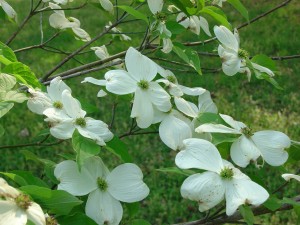This may be old news, but definitely worth repeating. Twenty five years ago a dreaded dogwood disease threatened to eliminate our beautiful spring flowering tree from our gardens. Appalachian Spring flowering dogwood (Cornus florida ‘Appalachian Spring’) was found at the Camp David Presidential Retreat atop Catoctin Mountain in Maryland.
Currently, Appalachian Spring is the only dogwood cultivar resistant to dreaded anthracnose (Discula destructiva) disease. It was introduced in 1990 by plant scientists at the University of Tennessee in Knoxville. These same scientists have also released four additional dogwood cultivars which are resistant to powdery mildew. Appalachian Spring is not resistant to powdery mildew disease.
Flowering dogwood is a small understory tree, preferring partial sunlight (morning and early afternoon hours are best). The white bracted flowers open in early spring in the Southern Appalachian region (USDA hardiness zones 6 and 7). Dogwood blooms heaviest in full day sun, but the tree’s life span is generally shorter. Two-year old established dogwoods exhibit good drought tolerant, but do benefit from irrigation during long dry spells. Mulching conserves soil moisture and cools the soil. Possible infestations of dogwood borer are also reduced.
Flowering dogwood grows in average garden soil that is well drained. Adding generous amounts of compost spread over the planting site (not the hole) is recommended. Young trees grow vigorously, often reaching 15 to 20 feet in height in 10 years. Feed dogwood(s) in late winter with 10-10-10 or equivalent fertilizer. In the fall green drupe fruit turn bright red, usually 2-3 weeks before the dogwood foliage turns bright red. Birds and other wildlife are dependent on dogwood mast over the fall and winter months.


 Posted in
Posted in 
